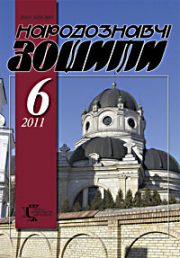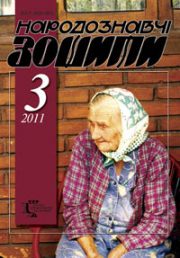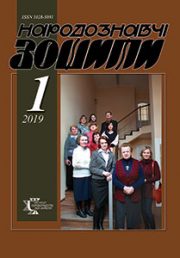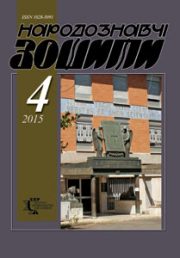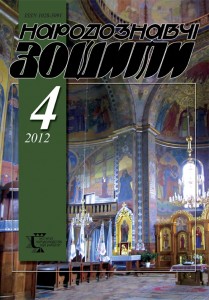2012 year, issue 4
Content
Pokotylo Hanna. On spiritual and creative values of the nature. P. 595-602
The broadening break between a human and nature has urged the humankind to review the life-asserting orientations of being, primarily to perceive the meaning of the nature as a condition of humanity’s survival. In humane mind the nature has got quite axiological dimensions by means of attributing itself via existentialities of such kind as Home, Field, Temple presenting the mental level and forming the modi of human existence in the world as well as the symbols of internal ethos. The Ukrainian ethnos has always had a characteristic attitude to the land as to sacred object. Here one might find the bases for corresponding to the environment and socially approved methods of agricultural, industrial and artistic activities. But now, under conditions of cynical practicality in progress there is the destruction of ecosystems — a process aiming to destruct the spirituality of aboriginal ethnical groups that have been left under the threat of loss their identities. So the imperative alarming claim is to save the nature and life on earth from destruction by usage the practical moral efforts of earthmen and magical power of art. The beauty is a kind of examination as for human qualities and naturalness of being.
Keywords: nature, land, native land, «home», «land», «temple», ethnos, life, humanity, spirituality, beauty, landscape.
Keywords: nature, land, native land, «home», «land», «temple», ethnos, life, humanity, spirituality, beauty, landscape.
Industrial property, being a part of intellectual property is a branch of civil law dealing with protection of inventions, specimens of industrial design, utility models, means of individualization for participants of a social circulation, as well as of wares and services, prevention of unfair competition. These issues form the basis for development and strengthening of a physical infrastructure of society, factor of intensification of scientific and technological progress. International and home normative and legal bases provide quite firm protection for mentioned items. This article contains criteria and procedures of acquiring legal protection of industrial property and financial results of their use.
Keywords: Industrial property, patent law, an invention, a utility model, trade name, industrial prototype, trademark, geographical directions, means of individualization of market wares and services, patent procedure, preliminary examination of the invention, the formal examination, qualifying examination, State Patent.
Keywords: Industrial property, patent law, an invention, a utility model, trade name, industrial prototype, trademark, geographical directions, means of individualization of market wares and services, patent procedure, preliminary examination of the invention, the formal examination, qualifying examination, State Patent.
In the article have been considered several aspects of problems connected with historio-political constructivism in Ukraine; attention has been paid to formation of differential rituals of the Ukrainian state after proclamation of independence at 1991. The author especially concentrates his study on views and ideas that had been or still are popular, but functioned as if «in the second level of circulation» of Ukrainian political discourse. Here have belonged whichever Biblical genealogies and historical reconstructions as well as suggestions that the territory of contemporary Ukraine had been a cradle of civilization, historically situated in the centre of the world.
Keywords: Ukraine, cradle of civilization, ploughman, Christianity, Paganism
Keywords: Ukraine, cradle of civilization, ploughman, Christianity, Paganism
Pylypchuk Sviatoslav. Ivan Franko as a researcher in non-fairy folkloristic prose. P. 622-633
The article has presented a complex analytical study of I. Franko’s achievements in scientific conceptualization of non-fairy folkloristic prose genres ( as legends, fables and stories). Different aspects of scholar’s research-works in the mentioned fields have been considered, as definitions, differentiations, origins, developmental tendencies and peculiarities of their occurrence, functional potentialities, means of artistic and expressive expressiveness, principles of recording and publication as well as receptions of those in the context of relative ethnological units. Especial attention has been paid to a number of Franko’s productive ideas that came through, in particular, quite successful checks as for his fundamental principles used by modern folklorists in studies on folk narrative stock.
Keywords: folk non-fairy prose, legend, story, fable, differentiation, definition, apocryphal literature, magic element, historicism.
Keywords: folk non-fairy prose, legend, story, fable, differentiation, definition, apocryphal literature, magic element, historicism.
The article written on the basis of field data, published sources and historiography has brought some results of analytic studies in the long-term means of weather forecast in connection with winter cycle of calendar holidays. The main means of forecasts as well as objects of observation have been described and characterized. The significance of forecasts as for agricultural works has been investigated.
Keywords: Candlemas, Christmas, forecast, calendar, weather.
Keywords: Candlemas, Christmas, forecast, calendar, weather.
The paper based upon field ethnographic data and literary sources presents an analysis of nominations, forms and attributes of scouting («vyviduvannya») wedding stage in the territories of ethnographical Volhynia. The results of this investigation are being called to solve the problem of defining the place of wedding ritual of Volhynia in the typological classification of the Ukrainian wedding ritual.
Keywords: scouting («vyviduvannya»), local names, forms, attributes.
Keywords: scouting («vyviduvannya»), local names, forms, attributes.
The article deals with design features of Polisia houses with combined structures of covering and lift slab. Variations of framed roof and arch-shaped ceiling have been analyzed. An attempt to discover the reasons for origin of the state and to trace the paths along which had been developed separate elements of the roof and ceiling have been presented and exemplified on the ground of Polisia housing.
Keywords: Полесье, жилище, крыша, потолок, «накот».
Keywords: Полесье, жилище, крыша, потолок, «накот».
In the study compiled by means of comparative approach to the broad range of ethnographical materials have been analyzed the Ukrainians’ divination practices with pegs. As a result a point had been stated that mantic acts had been connected with matrimonial rites of forthcoming wedding and spousal partner.
Keywords: fortune-telling (divinations), mantic and magic actions, peg, count, cord, fence, prophetic dream, marriage, girlhood.
Keywords: fortune-telling (divinations), mantic and magic actions, peg, count, cord, fence, prophetic dream, marriage, girlhood.
The world practice has attested the claim that cultural and artistic processes have been constantly related with intercultural contacts. Thus, in view of changes in Weltanschauung system and its separate components the art has responded to sharpness of situation by essential entity. That is why constant cultural ties with countries of Central and Western Europe had been developed and became quite regular factor in decorative formation of Eastern Galician architecture of the second half of 16th through the 17th cc.
Keywords: ornament, architecture, cultural contacts, symbolic decoration.
Keywords: ornament, architecture, cultural contacts, symbolic decoration.
In the article has been presented strict meaning of terms garden, park, gardening and park art and landscape architecture from explanatory and etymological vocabularies of home and foreign compiling. Especial attention has been paid to the primal source of meaning for those terms, i.e. the Holy Bible. Parallels in world religious doctrines as well as in different world cultures, as the Far East, Europe and Asia have been exposed.
Keywords: garden, park, gardening and park art, landscape architecture, religious adoration, myth, Adonis, Christianity, Eden.
Keywords: garden, park, gardening and park art, landscape architecture, religious adoration, myth, Adonis, Christianity, Eden.
The article has brought some results of a research-work in compositional principles of traditional folk icon painting on glass planes. In this respect, all mentioned icons have been divided into two groups, viz., those with a cartouche frame, as well as those in which the entire glass surface had been filled. The complexity of an icon’s composition had depended on the number of figures depicted and on the creative intention of the folk artist.
Keywords: icon on glass, cartouche, one-figure composition, multi-figural composition, creative interpretation.
Keywords: icon on glass, cartouche, one-figure composition, multi-figural composition, creative interpretation.
In the article have been analyzed some measures as for development of decorative and applied art in the land exemplified by creative works by craft-woman V. Nesteruk
Keywords: decorative and applied art, Rivne area, work.
Keywords: decorative and applied art, Rivne area, work.
Reznyk Oksana. On problems of stage designing in Volodymyr Blavatsky’s producing. P. 703-707
The prospects of Ukrainian art of staginess during the first half XX c. have been presented and brought under analytical study in Leonid Borovyk’s and Vladyslav Kleh’s vanguard artworks for theatrical productions by Volodymyr Blavatsky. Symbolism in art of stage design has been considered as a logical evolution phase of staginess art in Modernism.
Keywords: art of staginess, Vladyslav Kleh, Leonid Borovyk, Volodymyr Blavatsky, Symbolism, avant-garde, diaspora.
Keywords: art of staginess, Vladyslav Kleh, Leonid Borovyk, Volodymyr Blavatsky, Symbolism, avant-garde, diaspora.
In the article have been considered some problems concerning an artist’s creative adaptation under conditions of political totalitarianism in the Ukrainian SSR at 1950s to 1980s. The publication is based against reminiscences by Ivan Samotos, known Lviv sculptor, popular artist of Ukraine as well as against archival documents, proceedings of open and closed sessions, resolutions and decisions of party-bureau and party meetings at Lviv institute of applied and decorative art (now Lviv national academy of arts), letters, informative data, reports of governing structures, post-war and contemporary press.
Keywords: sculptor, Ivan Samotos, culture, post-war art, institute, activists of culture.
Keywords: sculptor, Ivan Samotos, culture, post-war art, institute, activists of culture.
In the article have been considered some problems in development of graphic art at Lviv in the period of 1900 to the mid-1930s. Attention has been paid to sources of Modernist styling in the Ukrainian art of that time as well as to means of intercultural communication and adapting the most significant universal artificial styles and directions (as Symbolism, Expressionism, Futurism, Constructivism) joint with purely national stylistic ideas (so-called neo-styles, as Neo-Byzantine one, Neo-Baroque, New Primitivism etc.). Some local specific features by Lviv graphic art of mature and late Modernism found in stylistic conglomerate of Art Deco have been underlined.
Keywords: fine art, graphic art, Modernism, Symbolism, Expressionism, Neo-Byzantine style, Art Deco, formal imaginative language, ethnical cultural tradition, print
Keywords: fine art, graphic art, Modernism, Symbolism, Expressionism, Neo-Byzantine style, Art Deco, formal imaginative language, ethnical cultural tradition, print
Yanoshchak-Pshybyla Oksana. On stove-tiles in stores of Figol family. P. 725-731
The article has presented a review of problems as for the artistic stove tile artifacts produced by famous Western Ukrainian craftsmen, gathered by Mykhailo Figol, eminent art scholar and painter stores and kept by scientist’s family. Under analytic study have been put the contents of the store, some features of personal creative styles have been defined with definitions of principles used in typological division of objects.
Keywords: stove tiles, ceramics, folk craftsman, tradition, Kosiv, Kolomyja, Hutsul land
Keywords: stove tiles, ceramics, folk craftsman, tradition, Kosiv, Kolomyja, Hutsul land
Kolomiets Lidiya. On origin and development of multisensory design in XX and XXI cc. P. 732-742
The article has presented some reasons for origination and means in development of multisensory design during XX and XXI cc. Author has paid especial attention to elaborations and experiments of leading contemporary design schools and exposes some theoretical and practical aspects of multisensory design with analyses in functional application of that within various types of sensuous/emotional influence (e.g. in emotional branding, relaxation, work, psychotherapy, medical cure) often appearing in present-day interior design.
Keywords: multisensory design, Bauhaus, futurism, branding, psychotherapy, sensory room, spa.
Keywords: multisensory design, Bauhaus, futurism, branding, psychotherapy, sensory room, spa.
In the article written on the ground of field materials have been considered some examples of wooden gates and fences. In the study has been claimed that after architectural and constructive design there had been four types of gates; each one has been accompanied with its characteristics. Findings have been made that proportions and artistic features of gates have been influenced by environmental conditions and by a landlord’s economical status as well as functional predestination; quite significant decorative part has been played by the upper part of folds and wickets. In the past every region had its own architectural decorative motif formed on the ground of geometrical, floral or anthropomorphic ornaments differentiated by inlaid details. In details have been reviewed decorations in the upper part of gates, sheds fronts and ridges. Classification of pillars after architectural decorative finishing has been presented with the finding that the mentioned finishing had dependent on artistic design of folds and sheds.
Keywords: gate, wicket, fence, décor.
Keywords: gate, wicket, fence, décor.
In the present article, the author has analyzed tremendous efforts of the public in Galychyna to preserve memorials of Ukrainian culture. The Scientific Association of T.~Shevchenko, associations «Prosvita», «Ridna Shkola» («Native School»), churchmen, as well as regional museum associations of Galychyna made an outstanding contribution in this respect. An attempt has been made to address their role and significance in establishment of Ukrainian ethnographic museum activities of Galychyna in the studied period.
Keywords: Scientific association, museum association, museum, ethnographic collection.
Keywords: Scientific association, museum association, museum, ethnographic collection.
Editors. The heritage of Ukrainian Art Scholarship An attempt of systematization. P. 775-775
read »
